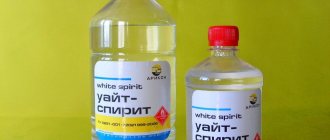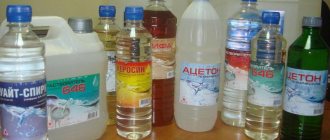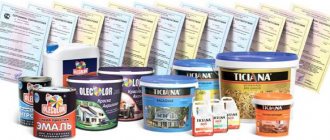Do I need to thin oil paints?
It is quite possible to use oil paints for painting without thinners. If the texture is soft enough and you like relief works, then feel free to paint with them in their pure form. However, the paint may have too thick a consistency and thicken over time. In this case, you will certainly be faced with the question of how to dilute oil paints. The main thing here is to understand that any solvent makes the work less bright. And if you use natural oils, keep in mind that the drying time of the finished painting will increase significantly. In any case, you need to keep such products in your arsenal so that you can wash your brushes and palette.
How long does it take for oil to dry without solvent?
Usually oil painting dries
2-3 days, but this process can take up to 7 days, depending on the thickness of the paint layer, air temperature and humidity, and also on the pigments in the paint itself.
Interesting materials:
What kind of workbench should it be? What should be the length of the garland? What should a bed for cucumbers be like? How wide should the corridor be? What motor should I put on sliding gates? Which company is better for aerated concrete? What brand of oil is poured into the walk-behind tractor? What format of the book can be printed? What video format do all DVD players read? What shape is the root of a pine tree?
Oil as a thinner
The first thing that comes to mind when asked about how to dilute oil paints is, of course, vegetable oils. Most often they use flaxseed or hemp. But it is best to carefully read the composition of the paint and choose a similar oil in an art store. This additive will make the material softer and more pliable. In addition, the work will have a characteristic shine. After drying, the painting will be covered with an invisible elastic film that will protect it from the destructive effects of external factors. If we talk about the disadvantages of such a diluent, it is worth noting the unpleasant suffocating odor.
Thinner for painting surfaces
Available materials can be used as a solvent for exterior and interior painting. Their selection is quite large.
This composition has steady popularity when diluting coloring products. The following types are used for working with oil solutions:
Attention! The mixture has a specific odor, so it is recommended to carry out work in a ventilated area.
Turpentine can be successfully replaced with white spirit. The demand and popularity of these products is explained by their wide distribution and availability. In addition, there are varieties on sale that do not have a strong unpleasant odor.
The work process when using such a composition is very convenient. The mixture does not evaporate as quickly as other solvents, which allows you to paint without haste. Also, white spirit when added does not change the color of the composition.
Regular white spirit has little ability to liquefy, so it is better to purchase purified
Solvent
This thinner for oil paints has the number 647. Product designation may vary and depends on the components included. It is not recommended to use solvent number 646 due to the presence of acetone in it.
It is not always easy to dilute oil paint with this substance: excess leads to a deterioration in the properties of the product.
Gasoline and kerosene
These options are recommended for use in the absence of other mixtures and only for outdoor use. A significant drawback of the solutions is the specific smell, which can cause dizziness and poisoning. This is due to rapid evaporation. But kerosene is the best solution when you need to dilute an old composition that has become very thick.
Drying oil
This is a universal solution; besides, drying oil is included in oil paints. But it must be taken into account that the diluent must correspond to the type of substance that is included in the coloring material.
To obtain the necessary information, you need to pay attention to the labeling of painting mixtures. The following designations are distinguished:
Correct identification of components helps to obtain the desired result.
Drying oil “Oxol” consists of 55% natural oils, 5% drying agent, the rest is white spirit; in its properties, “Oxol” is practically no different from natural drying oil, but its cost is much lower
Turpentine and white spirit
Purified turpentine is a good option for large-scale paintings. Oil paints for painting become quite viscous and do not dry for a long time, and therefore you will always have the opportunity to make adjustments to the work. However, never use household turpentine, only from an art store. This substance can make the paint appear yellow. As for mineral white spirit, it dries much faster than the previous substance. In addition, it is less finicky in storage and safer in terms of chemical composition. And the price of such a thinner is lower. However, if the substance is of poor quality, a white coating may appear on the finished work after drying.
The best solvents
There are quite a lot of substances that can be used to dissolve oil-based solvents.
Turpentine
This substance is often used to dilute oil paints. For this, the following types of composition are used:
The benefits of turpentine include the following:
The substance also has disadvantages:
White Spirit
This is a fairly popular product that is convenient to use. It doesn't evaporate too quickly, which helps you paint slowly.
The advantages of the composition include the following:
Artistic varnish
If you don’t know how to dilute oil paints, then try painting varnishes. But in no case should they be confused with top coats, which are applied about a year after painting. The varnish must contain wood resin and solvent. Oil paints for painting, diluted in this way, become more pliable and at the same time denser, which ensures good coverage. In addition, the finished painting becomes bright and shiny, which is quite difficult to achieve using only oil or thinner. After drying, the paint becomes more durable and resistant to external influences.
To make the structure of oil paint softer, a so-called double is often used. It consists of one part varnish and two parts linseed or hemp oil.
Tee recipe
Experienced artists prefer to prepare their own thinner for oil paints, taking into account their needs. The most common “tee” recipe includes the following components:
- pictorial varnish (it is better to choose dammar or mastic);
- hemp, linseed or poppy oil (the latter is considered one of the most transparent and pure);
- turpentine or solvent for artistic oil paints (white spirit is most often used).
All components are mixed in a clean glass container in equal proportions. The container must be tightly closed, otherwise the solvent will begin to evaporate and lose its properties.
Solvent for emulsion and adhesive paints
Emulsion paints are divided into water-based, latex, acrylic, polyvinyl acetate and water-dispersion. They can be applied to concrete, metal, wood or plaster surfaces. They are non-toxic and fireproof. Adhesive compositions are made based on aqueous solutions of organic polymers, for example, cellulose ether, polyvinyl alcohol, starch and casein. Their properties are very similar to emulsion ones, but are less resistant to moisture. Because of this, they are used for painting inside dry rooms. These types of paints and varnishes are practically odorless, and due to their simple composition they can be dissolved with ordinary water in small quantities.
Dried acrylic paint can be removed from tools by simply soaking it in a soapy solution. For acrylic-based paints, solvents such as white spirit, kerosene, solvent and gasoline are suitable.
Helpful information
Beginners and experienced artists alike will certainly appreciate the following tips.
Never use solvents from hardware stores, because they not only have an unpleasant odor, but also give the paint a yellow tint after drying.
Some thinners make the paint color fade, but as they evaporate, the color may become brighter again.
Before using a particular solvent when working on a painting, experiment on a test piece of canvas.
You should not use too much thinner, because oil paint can become loose and will not stick to the surface as well.
For quick drying, use turpentine or artistic varnish, and if you have to work for a long time, it is better to give preference to vegetable oil.
When working with solvents (especially chemical ones), wear gloves and gauze bandages, and do not forget to ventilate the room.
Always dilute a small amount of paint, because it cannot be stored in this form.
If you want to give your painting a pleasant aroma, then use cedar or fir varnish as a solvent.
Features of diluting artistic paints
To create more liquid coloring functions for painting, 4 types of solvents can be used:
- Based on vegetable oils;
- On varnish;
- Pinene diluent;
- "Double", "tee".
For artistic purposes, it is better to dilute the paint and varnish material using the first type of means. Vegetable and flaxseed oils are suitable.
The introduction of a solvent weakens the brightness of the color, but when the surface dries, the saturation usually returns.
The dissolution process must be carried out carefully so as not to create a loose coating. This process can lead to a mild effect; for this purpose, the selected species is gradually introduced, and the result obtained is checked as it is diluted.
If there is too much product, you will end up with a product that doesn’t adhere well to the canvas. It is recommended to use odorless options for such paints.
The dissolution process must be carried out carefully so as not to create a loose coating.
Can the thinner be reused?
Quite often, artists dip brushes stained with paint into a container of solvent. As a result, it becomes cloudy and, at first glance, absolutely unusable. Dirty diluent can be reused if filtered. First, let the liquid stand until sediment settles out, then pass it through a paper filter. The procedure must be repeated until the precipitate stops falling. Pour the filtered diluent into a clean glass container and screw the lid on tightly.
The right thinner for oil paints will make your work more vibrant and will also speed up the drying process.
Full lesson text
In this lesson you will learn how to mix thinner. It is used in oil painting, when we are doing underpainting, or when we are already working with color.
There are many different recipes for mixing thinner, and some of them are dangerous.
If you open several painting textbooks, or just books written by artists, you will find a bunch of different recipes. It gets to the point that some of them are incompatible with each other. One artist says, “This is a great recipe, it will make a very good thinner,” and another says, “Yes, if you do this, then your painting, as soon as you finish the work, will crumble, all the paints will be smeared, this is a curse, not a thinner.”
And your art teachers or just artist friends will say about the same thing. Someone will tell you to add a little sunflower oil to painting, paints, or something else. This is fraught with the fact that, indeed, with a poor thinner recipe, the painting may crumble prematurely, and the paints may lose their color.
How I personally mix the thinner
I use one recipe and stick with it. My teacher once told me about it, and in my experience, it’s quite comfortable to work with such a thinner. And its quality in terms of painting technology has been proven for at least a generation. It seems to me that it is better to be careful and not be afraid for the durability of the paintings than to make your work easier by mixing something into the paints and then tearing your hair out.
So, actually how to mix the thinner. We use dammar varnish, and pinene or turpentine. Actually, as a result we will get a diluted dammar varnish. Add about four to five parts of pinene or turpentine, and mix in one share of dammar varnish. In other words, we mentally divide our bottle into six (or five) parts, fill it with five-sixths (four-fifths) pinene, and add varnish on top.










